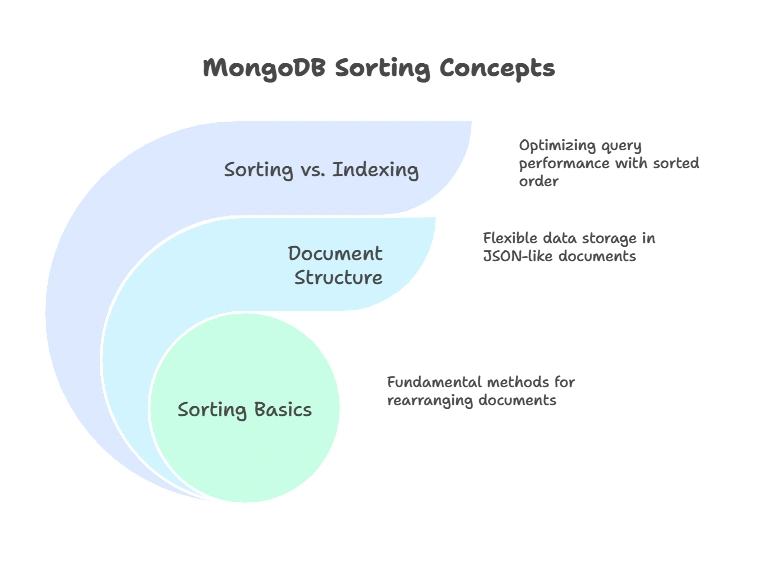Sorting Data in MongoDB
We will explore the various techniques for sorting data in MongoDB using Python. Sorting data is crucial for organizing information in a meaningful way, making it easier to analyze and present. We'll cover basic sorting methods as well as more advanced techniques to suit different requirements.
Understanding Sorting in MongoDB
We’ll cover the basics of sorting data in MongoDB and how it differs from traditional relational databases.
Understanding MongoDB’s Document Structure
MongoDB stores data in flexible, JSON-like documents, rather than tables with rows and columns. Each document can have its own structure, making sorting more dynamic compared to relational databases.
Sorting Basics
MongoDB allows sorting documents based on one or more fields. By default, sorting is done in ascending order. We’ll explore how to sort documents based on a single field and multiple fields.
Sorting vs. Indexing
While sorting rearranges documents temporarily for querying purposes, indexing optimizes query performance by maintaining a sorted order of documents on disk. We’ll briefly touch on the relationship between sorting and indexing.

Sorting Data in Python
In this section, we’ll dive into sorting data in MongoDB using Python code examples.
Sorting by Single Field
Let’s start with sorting documents based on a single field, such as “name” or “age”.
import pymongo
# Connect to MongoDB
client = pymongo.MongoClient("mongodb://localhost:27017/")
db = client["mydatabase"]
collection = db["customers"]
# Sorting documents by name in ascending order
result = collection.find().sort("name")
# Printing the sorted documents
for document in result:
print(document)
Explanation:
- We import the
pymongomodule and establish a connection to the MongoDB server running on localhost. - We select the database named
"mydatabase"and the collection named"customers". - We use the
find()method to retrieve all documents from the collection and sort them by the “name” field in ascending order using thesort()method. - Finally, we iterate over the sorted documents and print each one.
# Output
{ "_id": ObjectId("60fcd20e0459214e26d66d9e"), "name": "Alice", "age": 25 }
{ "_id": ObjectId("60fcd20e0459214e26d66d9d"), "name": "John", "age": 30 }
Sorting by Multiple Fields
We can sort documents based on multiple fields by specifying them in the sort() method.
# Sorting documents by age in descending order, then by name in ascending order
result = collection.find().sort([("age", -1), ("name", 1)])
# Printing the sorted documents
for document in result:
print(document)
Explanation:
- We use the
sort()method with a list of tuples to specify multiple sorting criteria. In this case, we sort documents by the “age” field in descending order (-1) first, and then by the “name” field in ascending order (1). - The result is a sorted cursor containing documents sorted first by age in descending order, and then by name in ascending order.
- We iterate over the sorted documents and print each one.
# Output
{ "_id": ObjectId("60fcd20e0459214e26d66d9d"), "name": "John", "age": 30 }
{ "_id": ObjectId("60fcd20e0459214e26d66d9e"), "name": "Alice", "age": 25 }
Sorting with Indexes
We can create indexes to optimize sorting performance. For example, creating an index on the “name” field can speed up sorting by name.
# Creating an index on the "name" field
collection.create_index([("name", pymongo.ASCENDING)])
# Sorting documents by name using the index
result = collection.find().sort("name")
# Printing the sorted documents
for document in result:
print(document)
Explanation:
- We create an index on the “name” field using the
create_index()method. This index will optimize sorting operations based on the “name” field, improving query performance when sorting by name. - We then use the
sort()method on the result offind()to sort the documents by the “name” field. Since we’ve created an index on the “name” field, MongoDB can utilize this index to efficiently perform the sorting. - Finally, we iterate over the sorted documents and print each one.
# Output
{ "_id": ObjectId("60fcd20e0459214e26d66d9e"), "name": "Alice", "age": 25 }
{ "_id": ObjectId("60fcd20e0459214e26d66d9d"), "name": "John", "age": 30 }
Advanced Sorting Techniques
In this section, we’ll explore advanced sorting techniques, including text search and sorting with aggregation pipelines.
Text Search and Sorting
MongoDB provides text search capabilities that allow sorting based on relevance scores. This is useful for applications requiring full-text search functionality.
Code Example: Text Search and Sorting
# Performing a text search and sorting by relevance score
result = collection.find({ "$text": { "$search": "example text" } },
{ "score": { "$meta": "textScore" } }).sort([("score", { "$meta": "textScore" })])
# Printing the sorted documents
for document in result:
print(document)
Explanation:
- We perform a text search using the
$textoperator and specify the search query"example text". - The
"$meta": "textScore"expression retrieves the relevance score for each document. - We sort the documents based on the relevance score using the
sort()method, specifying("score", { "$meta": "textScore" }).
# Output
{ "_id": ObjectId("60fcd20e0459214e26d66d9d"), "name": "John Doe", "description": "This is an example text document." }
{ "_id": ObjectId("60fcd20e0459214e26d66d9e"), "name": "Alice Smith", "description": "Another example text for searching." }
Sorting with Aggregation Pipelines
Aggregation pipelines offer powerful capabilities for sorting and processing data. We can perform complex sorting operations using aggregation stages like $sort and $group.
# Aggregating and sorting documents by age in descending order
pipeline = [
{ "$sort": { "age": -1 } }
]
# Executing the aggregation pipeline
result = collection.aggregate(pipeline)
# Printing the sorted documents
for document in result:
print(document)
Explanation:
- We define an aggregation pipeline with a single stage
$sort, which sorts documents by the “age” field in descending order (-1). - We then execute the aggregation pipeline using
aggregate(). - Finally, we iterate over the sorted documents returned by the aggregation pipeline and print each one.
# Output
{ "_id": ObjectId("60fcd20e0459214e26d66d9d"), "name": "John", "age": 30 }
{ "_id": ObjectId("60fcd20e0459214e26d66d9e"), "name": "Alice", "age": 25 }
Sorting data in MongoDB is a fundamental aspect of database management. By mastering sorting techniques in MongoDB with Python, you can efficiently organize and retrieve data to meet the needs of your applications. From basic sorting methods to advanced techniques, this topic has equipped you with the knowledge to effectively work with sorted data in MongoDB using Python. Happy Coding!❤️
